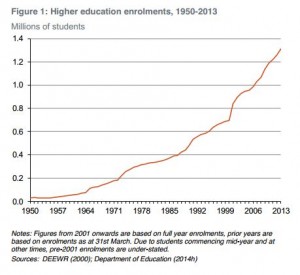I recently attended a Teaching and Learning Forum and was interested to hear some of the key challenges that Vice Chancellors face in Australia at the moment. They are:
- Funding – government support not able to keep up with rising costs associated with uncapped student enrolments;
- Massification of Higher Education – no longer educating an elite – responsible for training and retraining professionals throughout their careers with an increasing focus on ensuring career readiness;
- Technological revolution that is challenging higher education’s business model.
[This blog post will focus on the first two points and the third point will be discussed in a subsequent post.]
The first two points are clearly supported by the recent excellent report authored by Andrew Norton from the Grattan Institute – http://grattan.edu.au/wp-content/uploads/2014/10/816-mapping-higher-education-20141.pdf – and much of the following is extracted from this report.
Funding
In 2013 the revenues of Australia’s 40 full universities (includes Torrens University Australia), and about 130 other higher education providers exceeded $27 billion and it is interesting (scary) to see the huge importance of international student enrolments as they contributed approximately $5.1 billion of this revenue.
Despite significant efforts to diversify their funding base, about 60 per cent of the university cash flow is from government grants or loans and even without deregulation student debt is growing quickly. In mid-2013, HELP debtors owed the Commonwealth $30 billion, with $7 billion likely to be written off as a bad debt, however, just 12 months later this figure had increased to $34 billion, with $8.2 billion likely to be written off as bad debt.
This is unsustainable and I fear that with the likelihood of the Pyne Package MkII not passing the Senate this will mean the Federal Government will look to cut Higher Education costs with no offsets for the sector.
Massification of Higher Education
“Massification” is a clumsy term but it does describe the huge increase in student numbers in Higher Education in Australia in the 21st century (see figure below):
These numbers are made up of about 1M domestic students and just over 300,000 international students. This growth is being seen in both undergraduate and postgraduate areas and is having wide-ranging effects including:
- reduced staff job satisfaction as they struggle to educate less academically gifted students in larger classes with the same or reduced resources;
- students with low ATAR’s are being admitted to courses and this is leading to reduced retention rates given the direct correlation between the two. [it is interesting to see that the number of new students accepted by New Zealand universities for 2015 is down 20 per cent on last year with the NZ Qualifications Authority increasing entry standards following university requests. The Minister for Education stated, “It is not in the interests of any students to begin their university studies without the skills or experience necessary to succeed.”]
- over-enrolment in courses such as Law with graduates having difficulty finding careers in their chosen profession – see http://www.afr.com/p/national/legal_affairs/massive_pool_of_law_graduates_divides_OkByvywN8ZZh7E0ThQh5EL;
- increased casualisation of academic teaching staff as universities strive to manage their cost of educational delivery.
This is certainly not an exhaustive list but is meant to illustrate the changing macro environment in which educational technology companies such as Blackboard are working and helps to guide what combination of products, services and consulting can best assist the strategic direction of the university as it seeks to succeed in an increasingly competitive sector.
